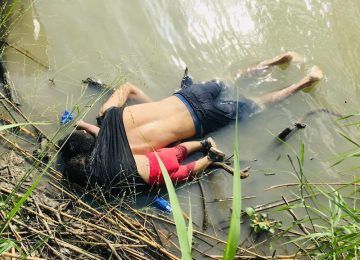Kenan Malik in Pandaemonium:
 The photos of Óscar and Valeria Ramírez, migrants from El Salvador, drowned in the Rio Grande as they tried to cross into the USA, are haunting and distressing, and have sparked outrage and anger in America. Four years ago, images of the Syrian toddler Alan Kurdi washed up on a Turkish beach similarly shocked and horrified Europe.
The photos of Óscar and Valeria Ramírez, migrants from El Salvador, drowned in the Rio Grande as they tried to cross into the USA, are haunting and distressing, and have sparked outrage and anger in America. Four years ago, images of the Syrian toddler Alan Kurdi washed up on a Turkish beach similarly shocked and horrified Europe.
These deaths are neither accidents nor isolated cases. They are the consequences of immigration policy, on both sides of the Atlantic, that aims at ‘deterring’ migrants. A little boy lying dead on a beach, a father and daughter face down in a river – that is what deterrence looks like.
At least 175 people, including 13 children, have died on the US-Mexican border this year alone. More than 2000 have died over the past 5 years. The European figures are more startling still. Almost 600 people have drowned in the Mediterranean so far this year. Since 1993, some 35,000 have died. Thousands more, perhaps tens of thousands more, will have perished in silence, their deaths never recorded. Alan Kurdi and Óscar and Valeria Ramírez are merely the cases in which the imagery was shocking enough to have caught public attention.
Immigration controls today mean not simply a border guard asking you for your papers. They constitute a violent, coercive, militarised system of control. When a journalist from Der Speigel magazine visited the control room of Frontex, the EU’s border agency, he observed that the language used was that of ‘defending Europe against an enemy’.
More here.
